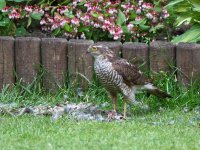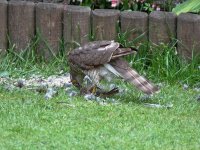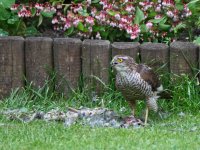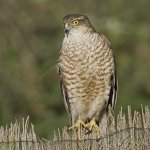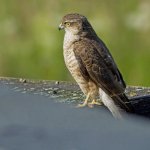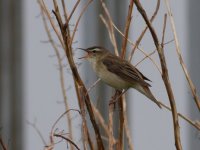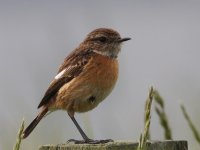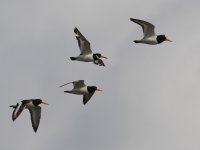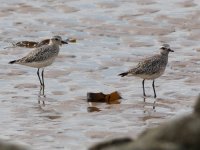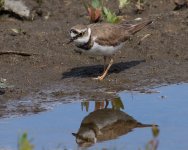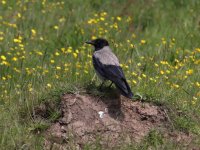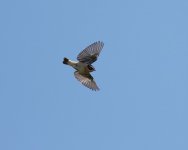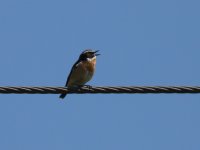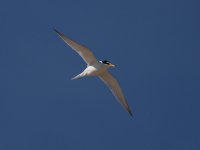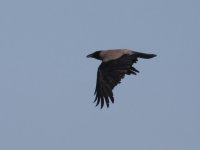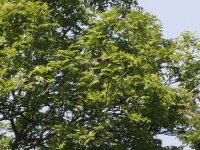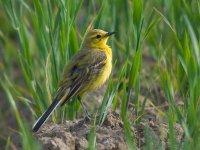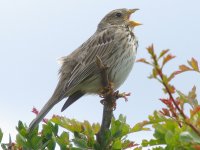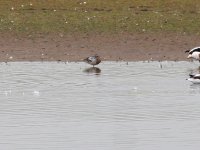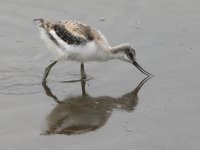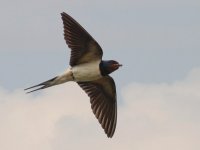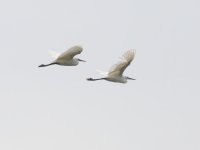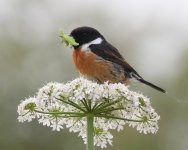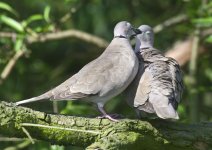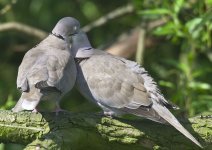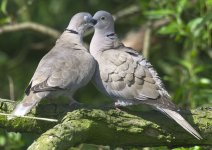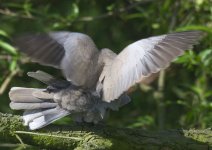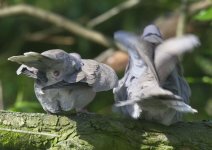-
Welcome to BirdForum, the internet's largest birding community with thousands of members from all over the world. The forums are dedicated to wild birds, birding, binoculars and equipment and all that goes with it.
Please register for an account to take part in the discussions in the forum, post your pictures in the gallery and more.
You are using an out of date browser. It may not display this or other websites correctly.
You should upgrade or use an alternative browser.
You should upgrade or use an alternative browser.
Durham Birding (6 Viewers)
- Thread starter Skelly
- Start date
More options
Who Replied?StevieEvans
Well-known member
Way out Wild West.
Had a look up the dale with The DBC's half man-half finch, managed to squeeze a bit spotting in whilst looking for likely sites for BO boxes.
Highlight was finding a male Green Woodpecker attending his nest tree, with noisy chicks inside.
Other residents of the woods included a pair of Marsh Tits, 3Buzzards, Sparrowhawk, 2 male Lesser Redpoll.
Several stunning Redstarts, 7+ males with one hovering in a glade only feet away. Close by a Woodcock sat at the side of the road.
Several Tree Pipits , 7 were still singing. With them & Meadow Pipits close together at one moorland edge. Despite an abundance of pipits only 1 Cuckoo today.
A couple of Bullfinch fed in Birch scrub at the edge of a Spruce plantation, with a family of Siskin close by. 4 Tawnies calling at various locations during the day.
Away from the woods & towards the Fells, waders were very busy - a couple of small post breeding flocks noted.
An oddity was a Snipe chipping away high above his rushy pasture, whilst perched on telegraph wires - how on earth he managed to find purchase on the wire with those over-sized feet, i dont know.
An untagged Red Kite drifted by ignoring the crows.
A cock Stonechat ferried food for his brood whilst 2 well fledged young close by were signs of an earlier success.
At one upland site a pair of Common Gulls looked to have set up home - despite the name, one of Englands scarcest breeding birds.
Other bits & bobs included Black Grouse, Spotted Flycatcher, RLPartridge, GCGrebe, Grey Wagtail, Heron etc etc
Very enjoyable afternoon.
Had a look up the dale with The DBC's half man-half finch, managed to squeeze a bit spotting in whilst looking for likely sites for BO boxes.
Highlight was finding a male Green Woodpecker attending his nest tree, with noisy chicks inside.
Other residents of the woods included a pair of Marsh Tits, 3Buzzards, Sparrowhawk, 2 male Lesser Redpoll.
Several stunning Redstarts, 7+ males with one hovering in a glade only feet away. Close by a Woodcock sat at the side of the road.
Several Tree Pipits , 7 were still singing. With them & Meadow Pipits close together at one moorland edge. Despite an abundance of pipits only 1 Cuckoo today.
A couple of Bullfinch fed in Birch scrub at the edge of a Spruce plantation, with a family of Siskin close by. 4 Tawnies calling at various locations during the day.
Away from the woods & towards the Fells, waders were very busy - a couple of small post breeding flocks noted.
An oddity was a Snipe chipping away high above his rushy pasture, whilst perched on telegraph wires - how on earth he managed to find purchase on the wire with those over-sized feet, i dont know.
An untagged Red Kite drifted by ignoring the crows.
A cock Stonechat ferried food for his brood whilst 2 well fledged young close by were signs of an earlier success.
At one upland site a pair of Common Gulls looked to have set up home - despite the name, one of Englands scarcest breeding birds.
Other bits & bobs included Black Grouse, Spotted Flycatcher, RLPartridge, GCGrebe, Grey Wagtail, Heron etc etc
Very enjoyable afternoon.
Last edited:
IanF
Moderator
Seaton Common - am - Stonechat pair, Whitethroat, Sedge Warbler, Meadow Pipit, Skylark, Swallow, Kestrel and Grey Partridge x2 along Zinc Works Road. Plus Yellow Wagtail, Lapwing and Redshank along North Gare road. No sign of the Hooded Crow this morning though a friend saw it this afternoon.
Migrant bushes - Linnet c.12 and Chafinch pair with four fledglings.
Seaton Snook - Ringed Plover, Heron, Grey Plover x2, Whimbrel x1, Mallard pair, Oystercatcher c.50. A few Common Tern and Cormorant flying by.
RSPB Saltholme - Wildlife Watchpoint - Yellow Wagtail, Little Ringed Plover, Little Grebe, Teal, Coot & Moorhen.
Paddy's Pool hide - Black-tailed Godwit x3, Lots of Common Tern (no chicks yet), Black-headed Gull with several chicks, Shelduck, Little Egret, Canada Goose c.30, Greylag Goose, Coot, Moorhen, Tuted Duck, Sand Martin, House Martin, Swift. Several Yellow Wagtail on approach to hide.
Photos: 1. Sedge Warbler - 2. Stonechat - 3. Oystercatcher - 4. Grey Plover - 5. Little Ringed Plover
Migrant bushes - Linnet c.12 and Chafinch pair with four fledglings.
Seaton Snook - Ringed Plover, Heron, Grey Plover x2, Whimbrel x1, Mallard pair, Oystercatcher c.50. A few Common Tern and Cormorant flying by.
RSPB Saltholme - Wildlife Watchpoint - Yellow Wagtail, Little Ringed Plover, Little Grebe, Teal, Coot & Moorhen.
Paddy's Pool hide - Black-tailed Godwit x3, Lots of Common Tern (no chicks yet), Black-headed Gull with several chicks, Shelduck, Little Egret, Canada Goose c.30, Greylag Goose, Coot, Moorhen, Tuted Duck, Sand Martin, House Martin, Swift. Several Yellow Wagtail on approach to hide.
Photos: 1. Sedge Warbler - 2. Stonechat - 3. Oystercatcher - 4. Grey Plover - 5. Little Ringed Plover
Attachments
StevieEvans
Well-known member
Bubble Bird
20:30 - 22:30
5 more singing Quail in eastern parts of NZ34 square, most in rough grass / weedy fields rather than cereals.
A couple of Little & Tawnies - seems to be a very poor breeding year for some of our owls.
Also Male Peregrine, Tree Sparrow, Grey Partridges.
Lots of Hares out & about.
20:30 - 22:30
5 more singing Quail in eastern parts of NZ34 square, most in rough grass / weedy fields rather than cereals.
A couple of Little & Tawnies - seems to be a very poor breeding year for some of our owls.
Also Male Peregrine, Tree Sparrow, Grey Partridges.
Lots of Hares out & about.
IanF
Moderator
Greenabella Marsh - am - Whinchat male still present behind substation.
Pair of Little Tern and pair of Ringed Plover at Seaton Carew.
Hooded Crow still present on Seaton Common.
Cowpen Bewley Woodland Park - 1.30pm - Hobby over main pond and old hide. Flew north along west side of hill and circled back towards pylons alongside Claxton Beck and lost from sight. In exact same spot as last September! Only managed a record shot as it flew away from me. Also Sparrowhawk pair and Kestrel. Kingfishers still feeding nestlings - five visits with fish in ten minutes! Should be fledging any day now.
Photos: 1. & 2. Whinchat 3. Little Tern - 4. Hooded Crow - 5. Hobby
Pair of Little Tern and pair of Ringed Plover at Seaton Carew.
Hooded Crow still present on Seaton Common.
Cowpen Bewley Woodland Park - 1.30pm - Hobby over main pond and old hide. Flew north along west side of hill and circled back towards pylons alongside Claxton Beck and lost from sight. In exact same spot as last September! Only managed a record shot as it flew away from me. Also Sparrowhawk pair and Kestrel. Kingfishers still feeding nestlings - five visits with fish in ten minutes! Should be fledging any day now.
Photos: 1. & 2. Whinchat 3. Little Tern - 4. Hooded Crow - 5. Hobby
Attachments
spuggy
Unsurpassed Сasual Dating - Verified Females

Yellow Wagtail
Bumped into 3 pairs of these obviously nesting in wheat fields just outside of Lumley I thought like Pied and Grey wagtails these would have preferred a waterside habitat for nesting but obviously not. I also caught up with a couple of Corn Buntings on DC's :t: patch that sat while I got a few photographs
Bumped into 3 pairs of these obviously nesting in wheat fields just outside of Lumley I thought like Pied and Grey wagtails these would have preferred a waterside habitat for nesting but obviously not. I also caught up with a couple of Corn Buntings on DC's :t: patch that sat while I got a few photographs
Attachments
bob freeman
Well-known member
Best shot of a Corn Bunting i have seen.
Well done Spuggy
Well done Spuggy
The Rev DA
Member
A Male Hen Harrier drifting high above Beamish / Handon Hold around 12 noon in clear skys -would have gone unnoticed if it had not been for a Red Kite circling nearby
quite a find!
David A
quite a find!
David A
ian hamilton
mackem born and bred
Timber Beach 0415-0530;
Cormorant
Grey Heron
2prs Shelduck with 4 and 3 duckings
pr Oystercatcher
3 Redshank
Lapwing
Herring Gull
Lesser Black-Backed Gull
Common Tern
Woodpigeon
Wren
Robin
Blackbird
Song Thrush
m Blackcap
Lesser Whitethroat singing
2 Whitethroat
4 Willow Warbler
Chiffchaff
Magpie
Jackdaw
Greenfinch
Goldfinch
m Reed Bunting
fox seen briefly as it dissapeared in the undergrowth
Cormorant
Grey Heron
2prs Shelduck with 4 and 3 duckings
pr Oystercatcher
3 Redshank
Lapwing
Herring Gull
Lesser Black-Backed Gull
Common Tern
Woodpigeon
Wren
Robin
Blackbird
Song Thrush
m Blackcap
Lesser Whitethroat singing
2 Whitethroat
4 Willow Warbler
Chiffchaff
Magpie
Jackdaw
Greenfinch
Goldfinch
m Reed Bunting
fox seen briefly as it dissapeared in the undergrowth
IanF
Moderator
Greatham Creek - Tidal Pool - am - Garganey drake mostly asleep in amongst the Shelduck. Redshank, Oystercatcher, Pied Wagtail, Mute Swan. Little Egret x3 flew south together from Greenabella towards Saltholme Ponds. Avocet chicks x24 -adults 19 - several chicks have been ringed this year - it will be interesting to see if they turn up elsewhere in due course.
Looks like most of the Common Tern may have deserted Saline Lagoon for some reason. Only three pairs visible amongst the vegetation though a few more more sat around the pool edges.
Seaton Common - Redshank, Yellow Wagtail x2, Heron, Skylark, Meadow Pipit, Stonechchat pair, Sedge Warbler, Whitethroat, Linnet x9.
Photos: 1. Garganey - 2. Avocet chick - 3. Swallow - 4. Little Egret - 5. Stonechat
Looks like most of the Common Tern may have deserted Saline Lagoon for some reason. Only three pairs visible amongst the vegetation though a few more more sat around the pool edges.
Seaton Common - Redshank, Yellow Wagtail x2, Heron, Skylark, Meadow Pipit, Stonechchat pair, Sedge Warbler, Whitethroat, Linnet x9.
Photos: 1. Garganey - 2. Avocet chick - 3. Swallow - 4. Little Egret - 5. Stonechat
Attachments
woodhornbirder
Well-known member
why are corn buntings "extinct" in northumberland but not durham? Theres plenty arable land in northumberland, and cant see that the farming techniques would be any different either.
any ideas?
any ideas?
JBee
Well-known member
Totally in love
Photographed a pair of collared doves two days ago and at first I thought one was feeding a youngster. I had a recollection that young collared doves don' have a ring and as it happened this was a pair of adults.
The bliss they showed as they went through 5 minutes of deep throat activity was really quite surprising. Even after mating there was a few minutes of gentle snuggling up.
What I am trying to find out is the technical term (if there is one) of the transfer of sperm from the male to the female as in one shot the "package" is clearly visible.
Photographed a pair of collared doves two days ago and at first I thought one was feeding a youngster. I had a recollection that young collared doves don' have a ring and as it happened this was a pair of adults.
The bliss they showed as they went through 5 minutes of deep throat activity was really quite surprising. Even after mating there was a few minutes of gentle snuggling up.
What I am trying to find out is the technical term (if there is one) of the transfer of sperm from the male to the female as in one shot the "package" is clearly visible.
Attachments
Alan Tilmouth
Well-known member
why are corn buntings "extinct" in northumberland but not durham? Theres plenty arable land in northumberland, and cant see that the farming techniques would be any different either.
any ideas?
Maybe they were just quicker/more proactive in Durham with some farms getting involved in agri-environment schemes faster? I'm sure some Durham birders will correct me but I think that one of the legacies of the breeding Bee Eaters a few years ago was that the farm in that area moved over to environmental stewardship in a big way. The NE now has a Farmland Bird Initiative Officer within the RSPB, GAry Woodburn and I know that he's working with a couple of farmers in Northumberland now to try and kick start a recovery.
StevieEvans
Well-known member
C.Bunt
Alan,
Corn Bunting is a very special bird for DBC - the club has a very pro-active Conservation team (all volunteers).
Many of the initiatives now in place & the practical measures implemented on the ground in Co.Durham, are as a direct result of the sterling work of the clubs Conservation Officer -John Olley.
The "Bee-eater Farm" - Farnless is one of the few local CBunt strongholds.
The RSPB's Gary Woodburn is leading a guided walk at Farnless Farm, Bishop Middleham on 21 June at 9.30am and will highlight the cutting edge conservation measures put in place on this site.
This follows up his fascinating Garys presentation (at DBC's April Indoor Meeting) about conservation of Corn Buntings
PS:
confirmation of breeding Corn Bunting in the north east of the Vice-County by DBC Chairman today.
Maybe they were just quicker/more proactive in Durham with some farms getting involved in agri-environment schemes faster? I'm sure some Durham birders will correct me but I think that one of the legacies of the breeding Bee Eaters a few years ago was that the farm in that area moved over to environmental stewardship in a big way.
The NE now has a Farmland Bird Initiative Officer within the RSPB, Gary Woodburn and I know that he's working with a couple of farmers in Northumberland now to try and kick start a recovery.
Alan,
Corn Bunting is a very special bird for DBC - the club has a very pro-active Conservation team (all volunteers).
Many of the initiatives now in place & the practical measures implemented on the ground in Co.Durham, are as a direct result of the sterling work of the clubs Conservation Officer -John Olley.
The "Bee-eater Farm" - Farnless is one of the few local CBunt strongholds.
The RSPB's Gary Woodburn is leading a guided walk at Farnless Farm, Bishop Middleham on 21 June at 9.30am and will highlight the cutting edge conservation measures put in place on this site.
This follows up his fascinating Garys presentation (at DBC's April Indoor Meeting) about conservation of Corn Buntings
PS:
confirmation of breeding Corn Bunting in the north east of the Vice-County by DBC Chairman today.
Last edited:
StevieEvans
Well-known member
Photographed a pair of collared doves two days ago and at first I thought one was feeding a youngster. I had a recollection that young collared doves don' have a ring and as it happened this was a pair of adults.
The bliss they showed as they went through 5 minutes of deep throat activity was really quite surprising. Even after mating there was a few minutes of gentle snuggling up.
What I am trying to find out is the technical term (if there is one) of the transfer of sperm from the male to the female as in one shot the "package" is clearly visible.
Not sure what the correct terminology is John, but the images remind us how interesting all bird species are - especially those we tend to overlook !
Similar threads
- Replies
- 0
- Views
- 624
Users who are viewing this thread
Total: 7 (members: 0, guests: 7)




